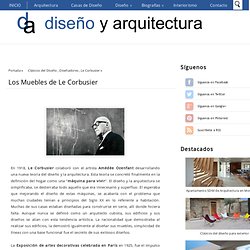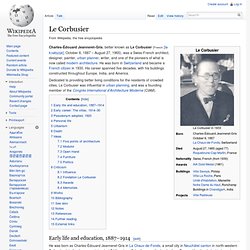

De Stijl. After World War I there was a turning away from old forms and philosophies among architects and designers, just as there was among artists and writers.

Many of the same abstract ideas came into play, as did ideas that incorporated the "machine" aesthetics of the new industrial age. In fact, one of the important trends of the 20th century would be the increasing parallels between - even merging of - art and design, which had been separated since the end of the renaissance. In the early 1920's a group of architects and artists, influenced by some of the ideas of DaDa, formed a movement called de Stijl (Dutch for The Style).
Theirs was a utopian philosophical approach to aesthetics, centered in a publication called de Stijl, which presented their ideas and designs. Le corbusier cat - Buscar con Google. Le corbusier cat - Buscar con Google. The modulor cat - Buscar con Google. DIY LE CORBUSIER FURNITURE PLANS - Buscar con Google. LECORBUSIER FURNITURE PLANS - Buscar con Google. DIY LE CORBUSIER FURNITURE PLANS - Buscar con Google. LECORBUSIER PLANS - Buscar con Google.
PLANO MUEBLE LECORBUSIER - Buscar con Google. Los Muebles de Le Corbusier. En 1918, Le Corbusier colaboró con el artista Amédée Ozenfant desarrollando una nueva teoría del diseño y la arquitectura.

Esta teoría se concretó finalmente en la definición del hogar como una "máquina para vivir". El diseño y la arquitectura se simplificaba, se desterraba todo aquello que era innecesario y superfluo. El esperaba que mejorando el diseño de estas máquinas, se acabaría con el problema que muchas ciudades tenían a principios del Siglo XX en lo referente a habitación.
Muchas de sus casas estaban diseñadas para construirse en serie, allí donde hiciera falta. Aunque nunca se definió como un arquitecto cubista, sus edificios y sus diseños se alían con esta tendencia artística. La Exposición de artes decorativas celebrada en París en 1925, fue el impulso definitivo para que este magnifico arquitecto, se lanzara al diseño de muebles. Si hay un diseño conocido de Le Corbusier y sus colaboradores, es el LC4, más conocida como Chaise Lounge. Más maestros del diseño moderno >>> Iconic Le Corbusier Chair Of Recycled Materials. Recycling materials is necessary today and it helps not to waste resources; recycled furniture is a cool green idea, and this Le Corbusier is one of such things.

Reincarnated into an icon, materials change their function and history. Le Corbusier - Wikipedia, the free encyclopedia. Charles-Édouard Jeanneret-Gris, better known as Le Corbusier (French: [lə kɔʁbyzje]; October 6, 1887 – August 27, 1965), was a Swiss-French architect, designer, painter, urban planner, writer, and one of the pioneers of what is now called modern architecture.

He was born in Switzerland and became a French citizen in 1930. His career spanned five decades, with his buildings constructed throughout Europe, India, and America. Dedicated to providing better living conditions for the residents of crowded cities, Le Corbusier was influential in urban planning, and was a founding member of the Congrès International d'Architecture Moderne (CIAM). Early life and education, 1887–1914[edit] He was born as Charles-Édouard Jeanneret-Gris in La Chaux-de-Fonds, a small city in Neuchâtel canton in north-western Switzerland, in the Jura mountains, just 5 kilometres (3.1 mi) across the border from France. Early career: The villas, 1914–30[edit] Pseudonym adopted, 1920[edit] Personal life[edit] Urbanism[edit] Le corbusier furniture - Google Search. Le corbusier. Le corbusier. Le Corbusier’s Modulor Man. In the early 1990′s I went on a three week architectural driving tour of France and Northern Spain with two friends.
The focus of the trip was visting buildings by Le Corbusier and we managed to visit Ronchamp, La Tourette and the Unité d’Habitation in Marseille. Whilst at the Unité, I took a photo of one of my friends standing against the Modulor man cast into the entrance area of the building. Sadly this photo appears to be lost to time, so I’ve taken the liberty of borrowing one from a rather fine set of images on Flickr and you’ll have to imagine Paul standing with his left arm in the air in the middle of this photo… The Modulor was a system of proportional measurement devised and developed by Le Corbusier throughout the 1940′s. His intention was to create (as summarised by Einstein) “a scale of proportions which makes the bad difficult and the good easy”.
Le corbusier. Le Corbusier. Le Corbusier. The modulor. How to make your the modulor. Architexts - Buffer Zone. A webcomic about architectural professionals About Buffer Zone:When you gotta go, you gotta go… but only if the coast is clear. –Maverick. Module9.pdf. Modulor. Commemorative Swiss coin showing the modulor.

It was developed as a visual bridge between two incompatible scales, the Imperial system and the Metric system. It is based on the height of a man with his arm raised. It was used as a system to set out a number of Le Corbusier's buildings and was later codified into two books. History[edit] Le Corbusier developed the Modulor in the long tradition of Vitruvius, Leonardo da Vinci's Vitruvian Man, the work of Leone Battista Alberti, and other attempts to discover mathematical proportions in the human body and then to use that knowledge to improve both the appearance and function of architecture. In 1943, in response to the French National Organisation for Standardisation's (AFNOR) requirement for standardising all the objects involved in the construction process, Le Corbusier asked an apprentice to consider a scale based upon a man with his arm raised to 2.20m in height.
Promotion[edit] Architecture: How exactly can you use "The Modular Man" (Le Corbusier's Theory) to design any space varying from a small residence to a huge city?